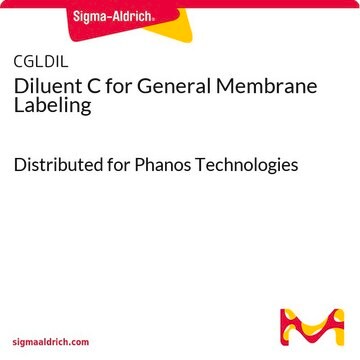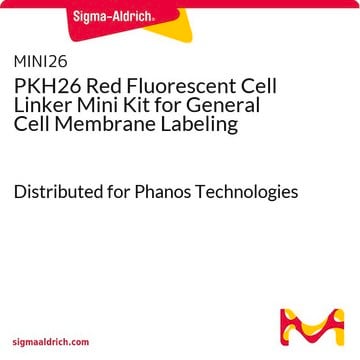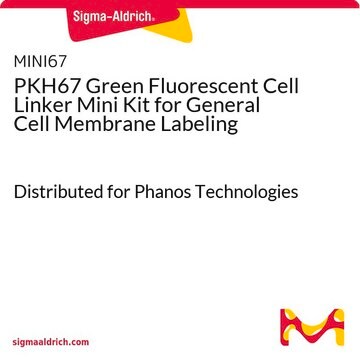BioTracker™ Membrane Dyes are lipophilic carbocyanine dyes. Lipophilic carbocyanine dyes have been used to stain neuronal cells in culture for several weeks, and in vivo for up to a year. The dyes do not appreciably affect cell viability and do not readily transfer between cells with intact membranes, allowing cell migration and tracking studies in mixed populations. The stability of labeling may vary between cell types, depending on rates of membrane turnover or cell division. Please see the link below to review the product datasheet:
https://www.sigmaaldrich.com/deepweb/assets/sigmaaldrich/product/documents/258/959/sct109ds.pdf
推荐产品
技术
cell based assay: suitable
检测方法
fluorometric
一般描述
Unlike PKH dyes, BioTracker Cytoplasmic Membrane Dyes do not require a complicated hypoosmotic labeling protocol. They are ready-to-use dye delivery solutions that can be added directly to normal culture media to label suspended or adherent cells in culture.
Spectral Properties
Absorbance: 366nm
Emission: 441nm
应用
Cell Imaging
Live Cell Dye
组分
2. 1 vial of 250µL Loading Buffer (CS224587)
质量
Absorbance: 366nm
Emission: 441nm
外形
储存及稳定性
Note: Centrifuge vial briefly to collect contents at bottom of vial before opening.
免责声明
储存分类代码
12 - Non Combustible Liquids
闪点(°F)
Not applicable
闪点(°C)
Not applicable
-
After the staining, I am planing to culture the cells about a week and do imaging. For how many days would the cells be stained? After the cell division, would the flouresence be approximately halved and would both cells be florescent?
1 answer-
Helpful?
-
-
Hi, How necessary is placing the coverslip or chamber slide in a humidity chamber? I tried staining adherent cells in a glass bottom dish following the steps excluding the humidity chamber and was unable to get clear results.
1 answer-
Placing the coverslip or chamber slide in a humidity chamber is necessary to help maintain a moist environment during the staining process. It helps to prevent the drying out of the cells and the staining medium, allowing for better diffusion and interaction between the labeling solution and the cells.
Helpful?
-
-
Does it stain bacterial membrane?
1 answer-
This product is a lipophilic carbocyanine dye intended for use in plasma membranes and cells. The uptake is dependent on the lipid bilayer. It is not tested for the suitability of bacterial membrane, however given the make up of the bacterial cell wall it is unlikely.
Helpful?
-
-
Is this dye compatible to image live migrating HL60 cells?
1 answer-
This product is suitable for live cell imaging. The HL60 cell line has not been specifically tested, however there is no reason to expect it will not work. While this stain is markely more photostable that DAPI and other similar dyes, the retention time has not been determined. The addition of verapimil is recommended to improve retention time. See the link below for the product data sheet. The protocol can be found on page 2.
https://www.sigmaaldrich.com/deepweb/assets/sigmaaldrich/product/documents/258/959/sct109ds.pdfHelpful?
-
Active Filters
我们的科学家团队拥有各种研究领域经验,包括生命科学、材料科学、化学合成、色谱、分析及许多其他领域.
联系技术服务部门







